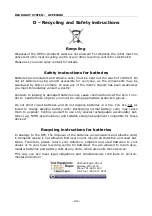
RP6 ROBOT SYSTEM - APPENDIX
7. With every program, the motors just accelerate very shortly up to a
high speed, and then immediately stop. Subsequently four red LEDs
start blinking!
●
The simplest possibility: You loaded a self-written or modified example pro-
gram to the robot and forgot to execute “
powerON();”
before starting the
motors!
●
Did you modify the software (especially the library) in any way? Try some
other programs and the self-test program.
●
If other programs and the self-test behave in a similar way: check the out-
put on the serial interface! Additionally to the 4 red blinking LEDs, the sys-
tem outputs an error message which you can look at in the terminal. Most
likely, the encoder system may cause this malfunction. Sometimes the ad-
justing collars, fixing the encoder wheels, may have detached, causing the
gearwheels to drift away from the sensors. In this case the encoder system
will stop delivering feedback signals! By the way: we provided the encoders
with potentiometers (=variable resisters) to adjust the sensors (use a fine
slot screwdriver or a suitable cross slot screwdriver. The self-test program
will show if the encoders work properly. We provided the program with a
special mode (c - Duty Cycle Test) to check the duty cycle for the square
wave signal. You can activate
WAVEFORM DISPLAYS
there from the “Dis-
plays” tab to take a look at the Encoder Signals. 50% duty cycle (50:50) is
optimal. However, deviations and fluctuations between 40 and 60% can be
considered as tolerable. Most of the duty cycle values should be in the range
of 45 up to 55% for RP6v2. During tests the test-program will deactivate the
motor-control and run the engines at a fixed PWM-value. Speed measure-
ment values will be shown in encoder counts per 200ms. It is NORMAL that
the speed of left and right will not be excatly the same and it is also normal
that the “speed” you enter is not the speed the motors rotate at (because
you do not enter a speed value there). This test deactivates the speed regu-
lation, so you just set a fixed PWM value there and the Motors start spinning
as they like. First try to start the Motors with a value like 50 and go from
there.
●
Maybe the encoder wheels have been damaged? For instance by oil or lub-
rication grease as described previously? Disassemble the gearwheel in front
of the Encoders – there is a silver fixing collar that you need to remove.
Then you can check the Encoder pattern (see Chapter 2.3.6. in this manual).
●
Check the cables to the encoder system for possible damage, e.g. by using a
Multimeter (switch the robot off and check every single wires for connection
between both ends and for short circuits to its neighbours!)!
●
Check the tiny IR reflection sensors of the encoders for polluted areas,
grease, dust or any other residues.
●
The LEDs will also start blinking as soon as one motor is (or both motors
are) malfunctioning – so check the wiring and the printed circuit board, es-
pecially near the motor drivers. Are there any loose metal objects on there?
Any short circuits due to damaged cables?
- 129 -










































